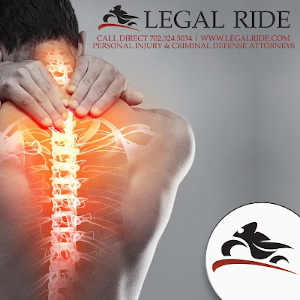
Continuing our series about injuries we motorcyclists suffer, last time we spoke about head injuries/TBI and how helmets can protect us. This time we write about spine injuries, and next time we will write about foot and ankle injuries.
Spine medicine seems to elude many attorneys. They know the buzz words, and maybe the anatomy, but not the details of the methodology of diagnosing the pain generators nor the tools doctors have to help manage or fix the pain generators.
The five basic structures in the spine are the bones or vertebra, the muscles, the nerves/spinal cord, the facets or joints, and the disc. Our spine is just a series of joints that enable to us to move forward, backwards and side to side. The vertebra attach to an adjacent vertebra above and below with a series of joints, all held together and controlled by muscles which attach to various spots on each bone. The spinal cord runs down through this column of vertebra, our spine, and each level, in between each pair of vertebra, nerves branch off the spinal cord and go out and innervate different parts of your body. Between each pair of vertebra, there is a disc that enables movement, and provides cushion.
The discs provide spacing between the bone, support the joints and create an opening where the nerves can exit at each pair of vertebra. We have 7 bones in the neck, each one numbers C1 to C7, 12 in our mid back, each numbers T1 to T12, and 5 in our low back, each number L1 to L5. We also each have a tail bone, most of us only have one fused bone, although some of us have more, number S1 and more if we have more. Each motion segment, or pair of vertebra, is identified by the adjacent bones, so the L4-5 segment for instance, is the fourth and fifth bones down in your low back. The L4-5 disc is the disc between these two bones.
As we age, we shrink in height, and get aches and pains. That is part of the natural process of our discs degenerating, and drying out, and losing disc space height. This puts pressure on the joints, makes the nerve root openings get smaller and causes irritation on those nerves, and the discs themselves can become painful, although the extent of this pain is highly debated in the medical field.
As riders, our spines are very susceptible to injuries. The primary injuries we get first consists of muscle based injuries, or sprains and strains. These are primary treated with medication to reduce inflammation and swelling and pain, along with chiropractic manipulation or physical therapy. These sort of injuries should resolve in a matter of several weeks to a few months typically.
The next series of injuries we tend to get are blunt force or axial load injuries, which manifest in compression fractures in the vertebra and some which result in deformity. Most of the time, these crush injuries are very painful, but non-surgical. They can result in instability which is primarily treated by braces or “turtle shells”. The other common vertebral injuries we suffer are broken off muscle attachment points, which again results primarily in instabilities that are treated with therapy or braces. A unique boney injury riders suffer are fractures of the spinous processes, or the bumps on the back of your spine that you can feel when you run your finger up or down the center of someone’s spine. There are a couple of more prominent ones that stick out a little more than the others and are more susceptible to fracture when we are vaulted over a car or other object, C7 and T8 are very common spots for these fractures. Again, they create instability and are not normally surgical.
Nerve root irritation can also occur, from muscle irritation and swelling, or disc injury, or crush injury to various parts of the spine. The testing for the nerve pain consists of diagnostic injections of anesthetic and steroids into the spaces surrounding the nerves and the subjective effect of these injections as reported by the patient. The only real treatment for these issues is therapy and medication go get muscle swelling to go away, or if its a disc or boney injury, then surgery to be described below.
The joints can become injured by loss of disc space height or axial compression or blunt force. The testing for this sort of injury depends on symptoms presented, but consistent of a similar injection of anesthetic into the joint and then recording the patient’s subjective response. The treatment for this type of injury is either surgery discussed below, or something called radio frequency ablation or rhizotomy, which is essentially a process where the doctor kills the nerve that sends the pain signal from the joint space to the brain. The medicine continues to evolve on this issue, but current theory is you can repeat this process every year for life. The body eventually reroutes the pain signal and the new pathway get zapped again the following year. Year after year.
The last type of common injury is injury to the disc itself. This is very controversial medicine. A bulge on the outer edge of the disc, depending on location, can interfere with the spinal cord or nerve roots. This causes pain. Surgery is a fix, but is elective. If there is a compression of the spinal cord or nerve roots, surgery is no longer elective, because loss of function and death of the nerves will occur from a compression. The disc can also spilt open, that is called a herniation, and the guts of disc can ooze out and cause the same sort of problems as a bulge. The fix for these issues can be as simple as trimming the disc with a laser, replacement of the disc (experimental) or removal of the disc as decried below. The controversial part of this medicine is when the nucleus of the disc is disrupted, but doesn’t actually herniate out of the disc. Doctors disagree about whether this sort of “internally disrupted disc” can cause pain, and how deeply a disc is actually innervated. But the fix for this sort of issue is removal of the disc and fusion of the joint space. The testing for this sort of internal disc disruption injury is called a discography, and consists of injecting the disc full of a dye under pressure, messing the pressure at which pain is duplicated and then sending the patient to a CT scan to see how far the dye penetrated out of the nucleus. The test if highly subject to manipulation by the doctor, such as by over pressurization of the disc, multiple hot discs, and other errors or false positives, which the doctors interpret as proof of necessity of surgery.
The ultimate surgical repair of a damaged motion segment, any part of two adjacent vertebra, their joints or their disc, is a fusion surgery. There are different types of fusions, but essentially, the motion of that segment is permanently ended by mechanically fusing the two adjacent discs together, and removing the disc and packing that disc space with a bony material, usually a paste made from cadaver bone, which eventually hardens and welds the two vertebra into one.
This is the most basic overview and outline of spine medicine for riders. It is important your lawyer has a very good working knowledge of spine medicine if you expect to be effectively represented and have your lawyer guide you through the process. We have gotten a lot of clients because their first attorney wasn’t effectively managing the medicine, and allowing the client to be medically mismanaged. Its important that your lawyer have a good relationship with the treating doctors, especially the pain manager, to be able to effectively authorize treatments and keep treatment on track, and keep it nice and neat and defendable. Meaning insurance lawyers are typically very good at the medicine and hurting cases by pointing out sloppy medicine. Our firm spent more than two decades on the insurance side, learning the medicine and cross examining doctors in deposition and trial, until we knew the medicine cold, period. Once we switched sides to represent injured riders and others, we brought that insurance lawyer knowledge to the table and now use it against the insurance companies.
Never hesitate to reach out if you want our help with a spinal injury case, or need a second opinion on your current case. The knowledge difference between one firm to the next can be the difference between a five or six figure outcome, and a seven or eight figure outcome for a spinal injury.
